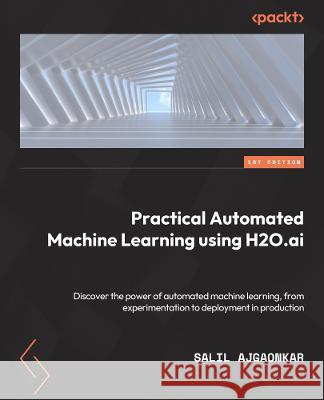Practical Automated Machine Learning Using H2O.ai: Discover the power of automated machine learning, from experimentation through to deployment to pro » książka
Practical Automated Machine Learning Using H2O.ai: Discover the power of automated machine learning, from experimentation through to deployment to pro
ISBN-13: 9781801074520 / Angielski / Miękka / 2022 / 396 str.
Practical Automated Machine Learning Using H2O.ai: Discover the power of automated machine learning, from experimentation through to deployment to pro
ISBN-13: 9781801074520 / Angielski / Miękka / 2022 / 396 str.
(netto: 170,24 VAT: 5%)
Najniższa cena z 30 dni: 178,26
ok. 16-18 dni roboczych
Dostawa w 2026 r.
Darmowa dostawa!
Accelerate the adoption of machine learning by automating away the complex parts of the ML pipeline using H2O.ai Key Features Learn how to train the best models with a single click using H2O AutoML Get a simple explanation of model performance using H2O Explainability Easily deploy your trained models to production using H2O MOJO and POJO Book DescriptionWith the huge amount of data being generated over the internet and the benefits that Machine Learning (ML) predictions bring to businesses, ML implementation has become a low-hanging fruit that everyone is striving for. The complex mathematics behind it, however, can be discouraging for a lot of users. This is where H2O comes in – it automates various repetitive steps, and this encapsulation helps developers focus on results rather than handling complexities. You'll begin by understanding how H2O's AutoML simplifies the implementation of ML by providing a simple, easy-to-use interface to train and use ML models. Next, you'll see how AutoML automates the entire process of training multiple models, optimizing their hyperparameters, as well as explaining their performance. As you advance, you'll find out how to leverage a Plain Old Java Object (POJO) and Model Object, Optimized (MOJO) to deploy your models to production. Throughout this book, you'll take a hands-on approach to implementation using H2O that'll enable you to set up your ML systems in no time. By the end of this H2O book, you'll be able to train and use your ML models using H2O AutoML, right from experimentation all the way to production without a single need to understand complex statistics or data science. What you will learn Get to grips with H2O AutoML and learn how to use it Explore the H2O Flow Web UI Understand how H2O AutoML trains the best models and automates hyperparameter optimization Find out how H2O Explainability helps understand model performance Explore H2O integration with scikit-learn, the Spring Framework, and Apache Storm Discover how to use H2O with Spark using H2O Sparkling Water Who this book is forThis book is for engineers and data scientists who want to quickly adopt machine learning into their products without worrying about the internal intricacies of training ML models. If you're someone who wants to incorporate machine learning into your software system but don't know where to start or don't have much expertise in the domain of ML, then you'll find this book useful. Basic knowledge of statistics and programming is beneficial. Some understanding of ML and Python will be helpful.











